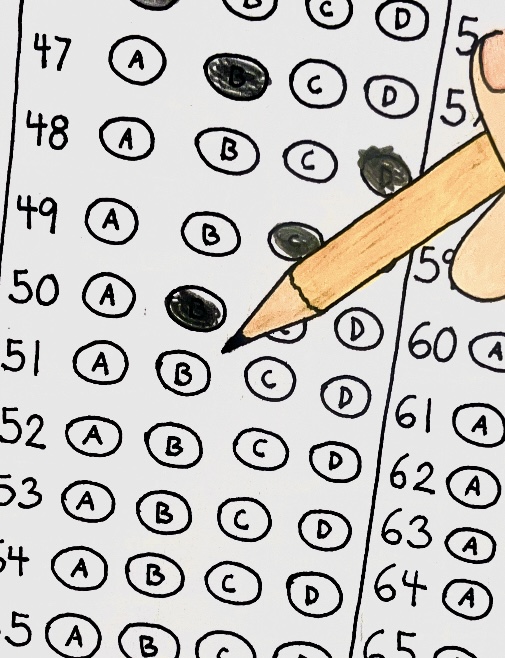For over a century, standardized testing has been used in college admissions to assess an applicant’s probability of thriving in a college environment. However, a student’s true capabilities go far beyond what can be measured by a singular performance on a random Saturday.
As a society, a culture has wrongfully been established that associates standardized testing statistics with an individual’s success. The entire process of standardized testing must be destigmatized, reducing the weight that it holds in the college admissions processes and recognizing that these tests are not an accurate measure of someone’s capabilities in higher education. While standardized testing should not be eradicated completely—as it can be beneficial for some students’ applications—it is unfair for students who struggle with testing to have their futures be determined by just a few hours of examination.
The graduating class of 2026 will be required to submit standardized testing scores to many highly ranked schools, including Harvard, Cornell and Brown, in the upcoming college admissions season. This marks a shift away from the brief period during and after the COVID-19 pandemic when many schools adopted test-optional policies, due to the inability of many students to take standardized tests. United States colleges and universities primarily accept the Scholastic Aptitude Test (SAT) and American College Test (ACT). Both tests analyze a student’s proficiency in reading, writing, language and mathematical skills in a timed setting, and the ACT additionally tests students on science.
According to the National Education Association, these tests began when Harvard University President Charles William Eliot proposed a system of common entrance examinations that would be accepted by schools nationwide instead of the individual tests previously given at each school. In 1900, the College Entrance Examination Board was established and the first standardized tests were administered.
Standardized tests were originally designed to level the playing field by ensuring that college admissions remain objective. In years past, the standardized testing system was intended to be a blind indicator for academic aptitude to assess prospective applicants. However, the process has since evolved, making the college admissions process increasingly elitist and thus negating the original purpose of the tests entirely by placing low-income students at a disadvantage.
In a report published by the University of Pennsylvania, researchers found that wealthier students earn higher SAT scores in comparison to lower income students. Affluent families have greater access to expensive SAT prep courses, private tutors and other resources that give privileged students unfair advantages. Students from low-income families are commonly unable to use outside resources to prepare for standardized tests, relying on aid provided to them through their high schools. Unfortunately, the majority of public high schools do not offer in-school tutoring for standardized tests.
Despite its original purpose of establishing objectivity, standardized testing has now become a competition to find the best prep resources, which are often unavailable to lower income students and their families.
Senior Eliora Crystal shared how standardized tests were not a contributing factor to her acceptance to Northeastern University, as she applied test-optional.
“There are so many other components to an application,” she said. “I took the SAT once and it wasn’t in the range for the school I wanted to go to, so I didn’t submit it. I ended up still getting into that school.”
On the other hand, fellow senior Samantha Sonnett said that her standardized test scores played a major role in her application during the college admission season this past year.
“Although I’m still waiting to hear back from a bunch of schools, I do feel that my SAT score made me a fairly competitive applicant,” she said.
However, Sonnett added that she believes test scores are not a fair judgement of every student’s capabilities.
“So many kids excel in areas that may not necessarily be a part of a standardized test,” she said. “I think that for students who don’t test well and have focus issues, standardized tests can be a disadvantage. The test only caters to certain abilities, and students with so many valuable qualities may not shine just because of the narrow set of concepts the tests cover.”
Standardized testing adheres to a very ‘one size fits all’ philosophy. Both the SAT and ACT assess students in a very specific, rigid format that may not align with every student’s learning style. Some students may excel in more creative, verbal or hands-on environments but struggle with the format of standardized tests. The SAT and ACT do not always accurately reflect the abilities of non-traditional learners who may still demonstrate high potential to thrive in a college setting.
Extracurricular activities and personal essays have become a larger focus in the college application process. As more schools start to emphasize a “holistic” approach to their admissions process, students have begun to focus more on supplemental short answer questions and student “passion projects.” These components of the application are a more direct demonstration of a student’s intentions for their future rather than a simple test score.
“I think my [Common Application statement] was really strong. I spent a lot of time working on that, [specifically] for Northeastern,” Crystal explained.
“Since Northeastern doesn’t have any supplemental essays, I would say my extracurriculars were a big priority,” she added. “I feel like you have to prioritize these things because they reflect what kind of person you are.”
Had standardized testing been able to provide an equal opportunity for students to showcase their academic abilities, it could be a valuable assessment tool. Unfortunately, since society places certain students at a disadvantage in the face of varying tutoring opportunities available per school or privately, standardized testing has become an outdated and simplistic practice.
Moreover, standardized tests take a serious toll on mental health in the long process of preparing for and actually taking these tests, especially in a society that has created a culture where students perceive their future to be heavily tied to their performance on a single exam. The high-stakes nature of the tests contribute to student anxiety and burnout.
Sonnett explained how she studied and took tests for six months before she achieved a score she was content with.
“I just felt so much pressure to perform well leading up to the day of,” she said. “It was definitely something hanging over my head for a long time and at the end of the day, you only have so many times to take the test and that is quite daunting.”
As the college admissions cycle progresses, schools must build a system that allows students to demonstrate their qualities and skills without being penalized for a test score that may not accurately reflect their ability to succeed in the future. Standardized testing is a flawed process that does not showcase the well-rounded nature of students.
“I think a good score can get a student through a lot of doors that maybe they wouldn’t have been able to get to otherwise,” Sonnett said. “But how you perform one time, on one day, on one test should not define your future.”










